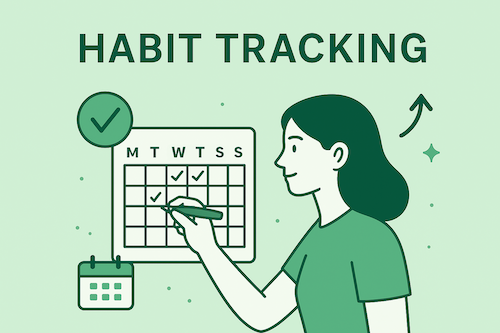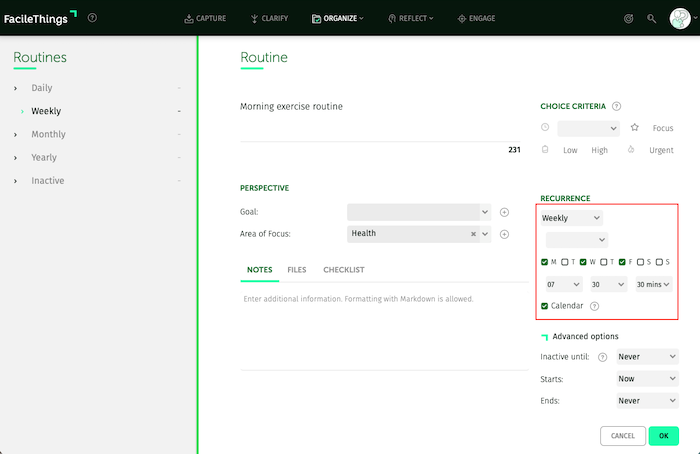Personal Productivity
Habit Tracking: Build Your Best Self Day by Day
AUTHOR: María Sáez
Habits are simple choices we make at certain moments and, over time, we stop thinking about them even though we continue to do them. The sum of all our small daily choices determines, in the long term, who we are: how we eat, how we work, whether we exercise, how we relate to others. An infinite number of small details that have a huge impact on all aspects of our lives.
According to science, habits work in three-step cycles:
- A cue triggers your brain to select the corresponding habit.
- A routine (physical, mental, or emotional) develops.
- There is a reward that helps your brain remember that behavior for the future.
This automatic process is what makes habits so powerful. Our brains constantly seek ways to minimize effort, so once a habit is formed, we execute the routine without consciously thinking about it. This is extraordinarily useful for positive behaviors, but it also means that negative habits are automatically repeated unless we deliberately act against them.
If you understand how habits really work, you have the ability to create them intentionally, modify them when they don’t serve you, and maintain them over time. And this is where habit tracking plays a key role: it’s the tool that gives you visibility into that automatic process, turning the invisible into the measurable.
What’s the point of tracking your habits?
Habit tracking is a practice that consists of systematically recording the execution (or non-execution) of specific actions that we want to integrate into our daily routine. Its main purpose is to create awareness about our behavior and maintain consistency in those actions that we consider valuable for our personal, professional, or health development.
When we track a habit, we turn something intangible and easy to forget into something tangible and measurable. This simple act of “writing it down” has a powerful psychological effect: it makes us accountable to ourselves and allows us to visualize our progress in a clear way.
What are the advantages?
- Visibility and awareness: By tracking whether or not we complete a habit each day, we become truly aware of our behavior. We often believe we are doing something consistently when in reality we are not. Tracking shows us the truth.
- Motivation through progress: Seeing a chain of consecutive days completed generates satisfaction and motivates us to continue. This effect, known as “not breaking the chain,” is especially powerful because we can immediately visualize our progress.
- Pattern identification: Systematic recording allows us to detect when we fail most often. Is it always the same day of the week? Are there specific times when we abandon the habit? This knowledge is very valuable for adjusting our strategy.
- Accountability: Even if it’s just to ourselves, keeping track creates a system of accountability that significantly increases the chances of staying committed.
- Data for continuous improvement: Over time, the accumulated record provides data on which habits really work for us, in those contexts we are most consistent, and how our habits relate to our overall well-being.
What are the alternatives?
- No formal tracking: Some argue that rigorous tracking can lead to anxiety or obsession. The alternative would be to simply practice the habit without recording it, trusting that automatic repetition will naturally take hold. However, this tends to be effective only for people with extremely high levels of discipline.
- Tracking by feeling: Performing a weekly or monthly self-assessment without daily logging, simply reflecting on how things have gone. It’s less accurate but requires less friction.
- Social monitoring: Sharing progress with others (a group, a partner, social media) rather than doing it privately. Social pressure can be motivating, but it can also be counterproductive if we fail.
- Results-based tracking: Focus on measuring the end result of the habit (weight, money saved, project completed) rather than simply recording whether you did it. It’s more motivating but less consistent for habits whose results are not immediate.
- Minimalist tracking: Record only occasionally or very simply, with a mark or a word, rather than creating detailed records. Reduce friction as much as possible.
How should it be done in general, regardless of the methodology used?
For habit tracking to be effective, regardless of the method you use, it’s best to follow some basic principles:
- Define the habit clearly: It’s not enough to say “I want to exercise more.” You need to be specific: “I will run for 30 minutes every morning” or “I will do 20 push-ups after breakfast.” Being specific makes it easier to keep track and eliminates any ambiguity about whether you completed the habit or not.
- Choose the right time to log: Decide when you will log each day. Many people do it at the end of the day, before going to sleep. Others do it immediately after performing the habit. The important thing is to be consistent, so that it becomes part of your routine.
- Keep friction low: The easier it is to track, the more likely you are to do it. A piece of paper on the wall, an app on your phone, or a box on a calendar. The most sophisticated system isn’t always the best if it requires more effort.
- Be realistic with the amount of habits: Don’t try to follow 20 habits simultaneously. Most people can consistently maintain between 3 to 5 new habits. Starting with a few increases the chances of success.
- Use a visual system: Whether it’s a physical calendar with marks, a color-coded spreadsheet, or an app, make your progress visually clear. Our brains respond well to visual patterns.
- Allow room for failure: Don’t abandon the system because of one bad day. Perfection is not the goal. A robust habit is one that can withstand the occasional day of non-completion without you giving up completely.
- Review regularly: Once or twice a week, take a moment to review your progress. Are there any patterns? Do you need to adjust anything? This reflection is what turns data into action.
- Link tracking to why you’re doing it: Always keep in mind the reason why you established that habit. When motivation slackens, remembering the purpose renews your commitment.
What should be done if the methodology used is GTD?
In Getting Things Done, habit tracking has a very specific place because the methodology focuses on managing actions, projects, and commitments that require conscious attention and decision-making. Truly automated habits—such as brushing your teeth after every meal or putting on your seatbelt when you get in the car—do not need formal tracking in GTD because they are no longer conscious decisions.
However, when you try to create a new habit, it’s not yet automatic and requires conscious attention. In GTD, you can manage it in two complementary ways:
- Through projects: Define the new habit as a project (“Establish a daily meditation habit” or “Create a morning exercise routine”). The project contains actions related to tracking and adjusting the habit. Each time you complete the habit, you can record it as a completed action within the project. This approach is useful if you have multiple steps or adjustments to make during the establishment phase.
- Using calendar routines: Create a recurring event in your calendar for the habit (for example, “Meditate 20 minutes” every morning at 7:00). The calendar in GTD acts as your specific time commitment system. The fact that it appears regularly in your daily view keeps the habit visible in your consciousness until it becomes automatic. Some users also add another recurring action in GTD (“Record progress of new habit”) to maintain accountability during the critical establishment phase.
The GTD system itself requires maintenance habits.
Consistent use of GTD itself depends on several fundamental habits: reviewing your inbox daily, performing the weekly review, checking your calendar, executing your next actions. These are not considered individual tasks, but rather routines that sustain the entire system. Although GTD does not require you to “follow” these habits in the traditional sense, many users find it helpful to:
- Block out time in your calendar for the weekly review (recurring event)
- Create a GTD maintenance project if you need to remember to restore discipline to the system
- At certain times, make “check inbox” an explicit action in GTD if you notice it’s piling up
Practical recommendation
The best approach in GTD is to use the calendar for new habits that require a specific time of day, and projects for habits that need constant monitoring and adjustment.
Once the habit is truly established and automatic, you can remove it from your GTD system entirely. The goal is for GTD to manage only those things that require your conscious attention, allowing true automatic habits to function in the background without taking up mental space.
What should you do if you use FacileThings as a personal management tool?
In FacileThings, habit tracking works very similarly to GTD, with the added advantage that the system automatically tracks your consistency in the habits you have established as routines.
The new habits you’re trying to establish can be managed by creating recurring events or routines in the FacileThings calendar.

The interesting thing about FacileThings is that the system automatically records every time you complete a routine (by marking it as “done”) and every time you don’t complete it (by throwing it in the trash). This internal tracking is invisible to you on a day-to-day basis, but it provides invaluable data about your actual consistency with each habit.
In the near future, we will develop routine tracking charts that will allow you to analyze your progress with each habit. You will be able to see patterns such as: which days of the week you’re most consistent, at what time of the year you maintain your habits best, or what your actual compliance rate is for each recurring routine. This information will allow you to identify when a habit is truly automated and can be considered “out of the system,” and when you need to intervene because you’re abandoning it.
Consistently mark actions as “done” when you complete them, or throw them in the trash when you can’t do them that day. The system will be tracking your progress in the background.

Once you feel that the habit is truly automated—when it no longer requires conscious effort or decision—you can consider removing it from the system to keep FacileThings focused on what really needs your conscious attention.






No comments